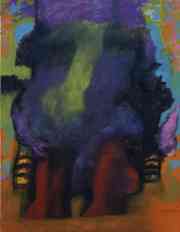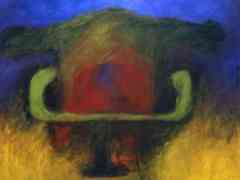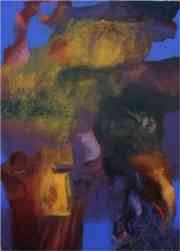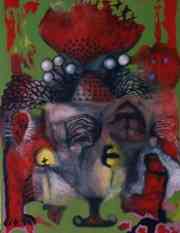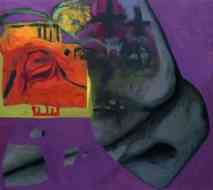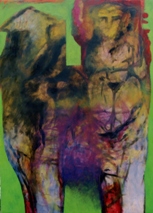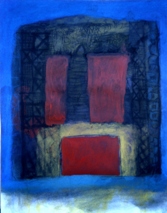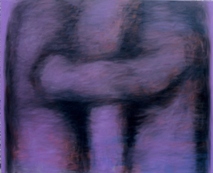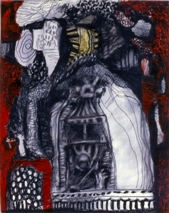|
|
1#
Prima che le cose avessero un nome |
|
Sergio Tamassia cerca forme che stanno dietro
le immagini che esistono già prima che noi abbiamo dato loro un
significato. C.G.Jung supponeva che questo genere di archetipi
fosse dato a tutti con i geni, come deposito di segni comuni.
L’etnologo americano Carl Schuster ha dimostrato, quasi senza
dubbio, che questi simboli possono essere identificabili in
tutti i popoli fino a un’origine
comune; dunque che vengono trasmessi attraverso una
memoria collettiva.Disegnando, S. Tamassia cerca di trovare
traccia di questa memoria; giocando con la forma e senza un
progetto copre i suoi fogli con segni, tratteggiature,
luci,ombre, condensa parte delle strutture, ne riprende altre
confondendo o coprendo. Evita interpretazioni possibili fino al
momento in cui la forma diventa attraente e apre a nuove
soluzioni. Molti quadri, nei loro significati, fanno pensare a
opere di culture antiche; dei mari del Sud dell’America
preistorica, o degli Aborigeni Australiani.Certamente questa
somiglianza non serve come prova per una memoria collettiva
perché anche S. Tamassia conosce le opere di questo genere.
Molto di più vale il fatto che le forme che ci fornisce senza
significato mettono in moto la nostra immaginazione. Secondo
Hans Blumenberg senza questa immaginazione conoscere e capire
non è possibile: “Avere mondo è sempre il risultato di un’arte”.
Prima Che le Cose Avessero Un Nome
(Before Things Had a Name)
Series of Paintings by Sergio Tamassia
Presentation, Erwin Schellenberger, Teacher of Fine Arts in Germany
In most of Sergio Tamassia’s paintings, at first glance, everything
is clear: the viewer clearly sees shapes that are familiar to him.
Frequently, a contrasting background increases the conciseness of
these shapes.
At second glance, nothing is clear: as soon as the viewer attempts
to identify these forms, something strange happens. The forms cannot
be committed to meanings, as the images they evoke arise only in the
mind of the viewer. These shapes inspire the imagination and a
fantasy that makes every viewer recognize their own individual
images.
Sergio searches for shapes that stand behind the pictures; shapes
that have already existed long before we have given them their
current meanings. C. G. Jung assumed that such archetypes were given
to people as a common stock of signs anchored in their genes. The
American anthropologist Carl Schuster discovered that these signs
and symbols can be traced back to a common origin in all peoples.
This means they are passed on within a collective memory.
Through his paintings, Sergio wants to trace this collective memory.
It seems that he starts painting in a playful and unintentional way
with traces, hatching styles and patterns, compacting parts of the
emerging structures and reducing others by blurring or overlaying
other transparent layers. He avoids any early definition, escapes
from possible interpretations, until to him the form becomes visible,
which he then highlights in a strong manner. During his work process,
again and again, he pauses to discover the forms that emerge; some
of the paintings are laid aside for some time and are further
processed after further examination. Often several paintings are
created simultaneously, and their close relationship is visible.
In their symbolic structure many of Sergio’s images remind us of the
works of earlier cultures, of artifacts of the South Seas, ancient
America or the Australian Aborigines. This similarity is not
astonishing given that these images exist in our collective
memory-memory that resonates inside Sergio.
Although his paintings evoke connections of this collective memory,
their greater value is the connections made with the viewer. Because
from the beginning of his process, Sergio offers shapes and forms
without ascribing meaning; thus, he sets our imagination in motion.
According to Hans Blumenberg, without this power of imagination,
recognition and understanding are not possible: the representation
of reality of the world is always the result of art.
Ervin Schellenberger

